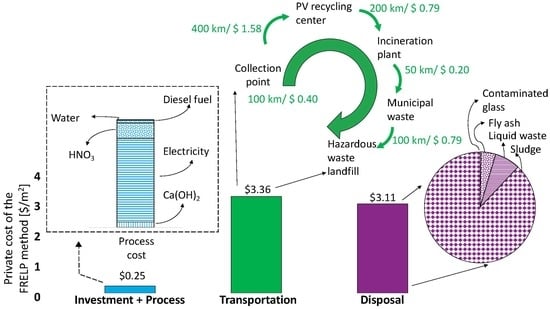Private and Externality Costs and Benefits of Recycling Crystalline Silicon (c-Si) Photovoltaic Panels
Abstract
1. Introduction
2. Method
2.1. Data Collection
2.2. Private Cost
2.3. External Cost
2.4. Benefits
3. Results
3.1. Private Cost of Recycling
3.2. External Cost of Recycling
3.3. Cost–Benefit Analysis of Recycling
3.4. Comparing the Cost of Virgin Materials to Recovered Materials
4. Conclusions
Supplementary Materials
Author Contributions
Funding
Conflicts of Interest
Nomenclature
| Abbreviation | Explanation |
| P.CInv | Private cost of investment |
| P.CP | Private cost of process |
| P.CP,m | Private cost of materials |
| P.CP,e | Private cost of electricity |
| E.CP | External cost of process |
| B.R,m | Benefit cost of recovered materials |
| P.CF | Private cost of diesel fuel |
| E.CT | External cost of transportation |
| P.CFee | Private cost of landfill tipping fee |
| E.CL | External cost of incineration emissions |
| B.R,e | Benefit cost of recovered energy |
| CED | Cumulative Energy Demand |
| Ecotox.,F | Freshwater ecotoxicity |
| Eutrop.,M | Marine eutrophication |
| Eutrop.,F | Freshwater eutrophication |
| Acid. | Acidification |
| O3 Form. | Photochemical ozone formation |
| PM | Particulate matter |
| Human tox., NC | Human toxicity, non-cancer effects |
| Human tox., C | Human toxicity, cancer effects |
| GWP | Global warming potential |
References
- Celik, I.; Mason, B.E.; Phillips, A.B.; Heben, M.J.; Apul, D. Environmental impacts from photovoltaic solar cells made with single walled carbon nanotubes. Environ. Sci. Technol. 2017, 51, 4722–4732. [Google Scholar] [CrossRef] [PubMed]
- Ahangharnejhad, R.H.; Phillips, A.B.; Ghimire, K.; Koirala, P.; Song, Z.; Barudi, H.M.; Barudi, A.; Sengupta, M.; Ellingson, R.J.; Yan, Y.; et al. Irradiance and temperature considerations in the design and deployment of high annual energy yield perovskite/CIGS tandems. Sustain. Energy Fuels 2019, 3, 1841–1851. [Google Scholar] [CrossRef]
- Celik, I.; Philips, A.B.; Song, Z.; Yan, Y.; Ellingson, R.J.; Heben, M.J.; Apul, D. Energy Payback Time (EPBT) and Energy Return on Energy Invested (EROI) of perovskite tandem photovoltaic solar cells. IEEE J. Photovolt. 2017, 8, 2156–2161. [Google Scholar] [CrossRef]
- Briese, E.; Piezer, K.; Celik, I.; Apul, D. Ecological network analysis of solar photovoltaic power generation systems emily. J. Clean. Prod. 2019, 223, 368–378. [Google Scholar] [CrossRef]
- Celik, I.; Song, Z.; Cimaroli, A.; Yan, Y.; Heben, M.; Apul, D. Life Cycle Assessment (LCA) of perovskite PV cells projected from lab to fab. Sol. Energy Mater. Sol. Cells 2016, 156, 157–169. [Google Scholar] [CrossRef]
- Celik, I.; Phillips, A.B.; Song, Z.; Yan, Y.; Ellingson, R.J.; Heben, M.J.; Apul, D. Environmental analysis of perovskites and other relevant solar cell technologies in a tandem configuration. Energy Environ. Sci. 2017, 10, 1874–1884. [Google Scholar] [CrossRef]
- Lunardi, M.M.; Alvarez-Gaitan, J.P.; Bilbao, J.I.; Corkish, R. A review of recycling processes for photovoltaic modules. Sol. Panels Photovolt. Mater. 2018. [Google Scholar] [CrossRef]
- Fiandra, V.; Sannino, L.; Andreozzi, C.; Graditi, G. End-of-life of silicon PV panels: A sustainable materials recovery process. Waste Manag. 2019, 84, 91–101. [Google Scholar] [CrossRef]
- Jung, B.; Park, J.; Seo, D.; Park, N. Sustainable system for raw-metal recovery from crystalline silicon solar panels: From noble-metal extraction to lead removal. ACS Sustain. Chem. Eng. 2016, 4, 4079–4083. [Google Scholar] [CrossRef]
- Wu, S.R.; Celik, I.; Apul, D.; Chen, J. A social impact quantification framework for the resource extraction industry. Int. J. Life Cycle Assess. 2019, 24, 1898–1910. [Google Scholar] [CrossRef]
- Celik, I.; Song, Z.; Phillips, A.B.; Heben, M.J.; Apul, D. Life cycle analysis of metals in emerging photovoltaic (PV) technologies: A modeling approach to estimate use phase leaching. J. Clean. Prod. 2018, 186, 632–639. [Google Scholar] [CrossRef]
- Deng, Y.; Liu, H.; Zhao, X.; Jiaqiang, E.; Chen, J. Effects of cold start control strategy on cold start performance of the diesel engine based on a comprehensive preheat diesel engine model. Appl. Energy 2018, 201, 279–287. [Google Scholar] [CrossRef]
- Beránek, V.; Olšan, T.; Libra, M.; Poulek, V.; Sedláček, J.; Dang, M.Q.; Tyukhov, I.I. New monitoring system for photovoltaic power plants’ management. Energies 2018, 11, 2495. [Google Scholar] [CrossRef]
- Willuhn, M. Global PV Market: 114 GW to Be Installed in 2019, with Continued Growth Onwards; PV Magazine: Berlin, Germany, 2019. [Google Scholar]
- Celik, I. Eco-Design of Emerging Photovoltaic (PV) Cells; University of Toledo: Toledo, OH, USA, 2018. [Google Scholar]
- Giwa, A.S.; Xu, H.; Wu, J.; Li, Y.; Chang, F.; Zhang, X.; Jin, Z.; Huang, B.; Wang, K. Sustainable recycling of residues from the food waste (FW) composting plant via pyrolysis: Thermal characterization and kinetic studies. J. Clean. Prod. 2018, 180, 43–49. [Google Scholar] [CrossRef]
- Tao, J.; Yu, S. Review on feasible recycling pathways and technologies of solar photovoltaic modules. Sol. Energy Mater. Sol. Cells 2015, 141, 108–124. [Google Scholar] [CrossRef]
- Smith, Y.R.; Bogust, P. Review of solar silicon recycling. Miner. Met. Mater. Ser. Part F 2018, 6, 463–470. [Google Scholar]
- Maani, T.; Celik, I.; Heben, M.J.; Randall, J. Environmnetal impacts of recycling crystalline silicon (c-Si) and cadmium telluride (CdTe) solar panels. Sci. Total Environ. 2020, 735, 138827. [Google Scholar] [CrossRef]
- Latunussa, C.E.L.; Ardente, F.; Blengini, G.A.; Mancini, L. Life cycle assessment of an innovative recycling process for crystalline silicon photovoltaic panels. Sol. Energy Mater. Sol. Cells 2016, 156, 101–111. [Google Scholar] [CrossRef]
- Deng, R.; Chang, N.L.; Ouyang, Z.; Chong, C.M. A techno-economic review of silicon photovoltaic module recycling. Renew. Sustain. Energy Rev. 2019, 109, 532–550. [Google Scholar] [CrossRef]
- Choi, J.K.; Fthenakis, V. Design and optimization of photovoltaics recycling infrastructure. Environ. Sci. Technol. 2010, 44, 8678–8683. [Google Scholar] [CrossRef]
- Cucchiella, F.; D’Adamo, I.; Rosa, P. End-of-Life of used photovoltaic modules: A financial analysis. Renew. Sustain. Energy Rev. 2015, 47, 552–561. [Google Scholar] [CrossRef]
- di Nola, A.; Flondor, P.; Leuştean, I. MV-modules. J. Algebr. 2003, 267, 21–40. [Google Scholar] [CrossRef]
- Fthenakis, V.M. End-of-life management and recycling of PV modules. Energy Policy 2000, 28, 1051–1058. [Google Scholar] [CrossRef]
- Choi, J.-K.; Heo, J.-B.; Ban, S.-J.; Yi, S.-M.; Zoh, K.-D. Source apportionment of PM2.5 at the coastal area in Korea. Sci. Total Environ. 2013, 447, 370–380. [Google Scholar] [CrossRef]
- Worx, R. How Much Do Industrial Robots Cost. Available online: https://www.robots.com/faq/how-much-do-industrial-robots-cost (accessed on 8 October 2019).
- Alibaba Manufacturers, Suppliers, Exporters & Importers. Available online: https://www.alibaba.com/?spm=a2700.details.scGlobalHomeHeader.9.df0b7eeeTwMxhR (accessed on 19 July 2019).
- Pizzol, M.; Weidema, B.; Brandao, M.; Osset, P. Monetary valuation in life cycle assessment: A review. J. Clean. Prod. 2015, 86, 170–179. [Google Scholar] [CrossRef]
- Keijzer, E. The environmental impact of activities after life: Life cycle assessment of funerals. Int. J. Life Cycle Assess. 2017, 22, 715–730. [Google Scholar] [CrossRef]
- Martinez-Sanchez, V.; Levis, J.W.; Damgaard, A.; DeCarolis, J.F.; Barlaz, M.A.; Astrup, T.F. Evaluation of externality costs in life-cycle optimization of municipal solid waste management systems. Environ. Sci. Technol. 2017, 51, 3119–3127. [Google Scholar] [CrossRef]
- Environmental Prices Handbook 2017 Methods and numbers for valuation of environmental impacts. 2018, pp. 1–177. Available online: https://www.cedelft.eu/en/publications/2113/envionmental-prices-handbook-2017 (accessed on 17 July 2019).
- Faircloth, C.C.; Wagner, K.H.; Woodward, K.E.; Rakkwamsuk, P.; Gheewala, S.H. The environmental and economic impacts of photovoltaic waste management in Thailand. Resour. Conserv. Recycl. 2019, 143, 260–272. [Google Scholar] [CrossRef]
- Rabl, A.; Spadaro, J.V.; Zoughaib, A. Environmental impacts and costs of solid waste: A comparison of landfill and incineration. Waste Manag. Res. 2008, 26, 147–162. [Google Scholar] [CrossRef]
- USGS. Commodity Statistic and Information; USGS: Reston, VA, USA, 2018. [Google Scholar]
- D’Adamo, I.; Miliacca, M.; Rosa, P. Economic feasibility for recycling of waste crystalline silicon photovoltaic modules. Int. J. Photoenergy 2017, 2017, 1–7. [Google Scholar] [CrossRef]
- Li, Z.; Zhao, Y.; Wang, X.; Sun, Y.; Zhao, Z.; Li, Y.; Zhou, H.; Chen, Q. Cost Analysis of perovskite tandem photovoltaics. Joule 2018, 2, 1559–1572. [Google Scholar] [CrossRef]

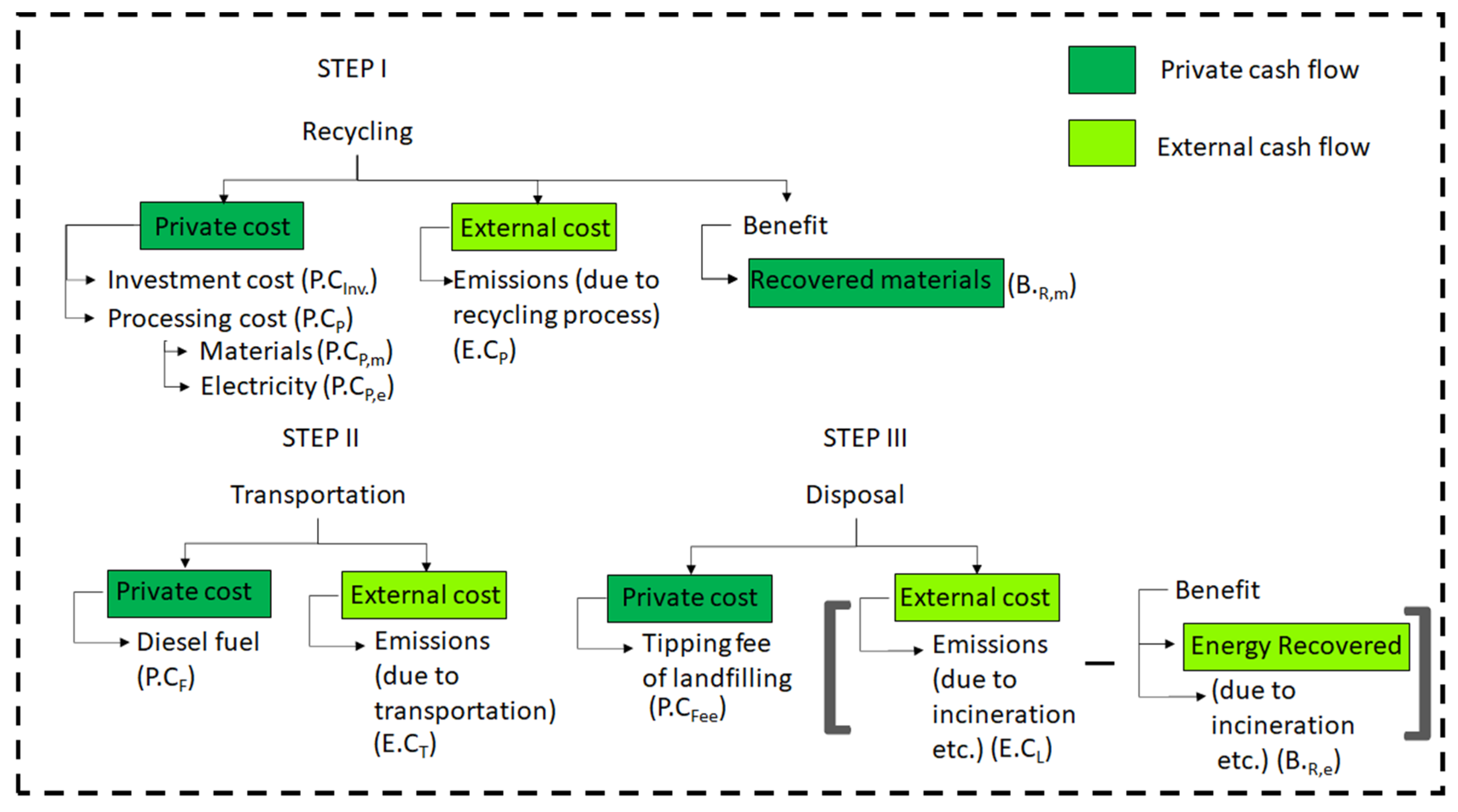

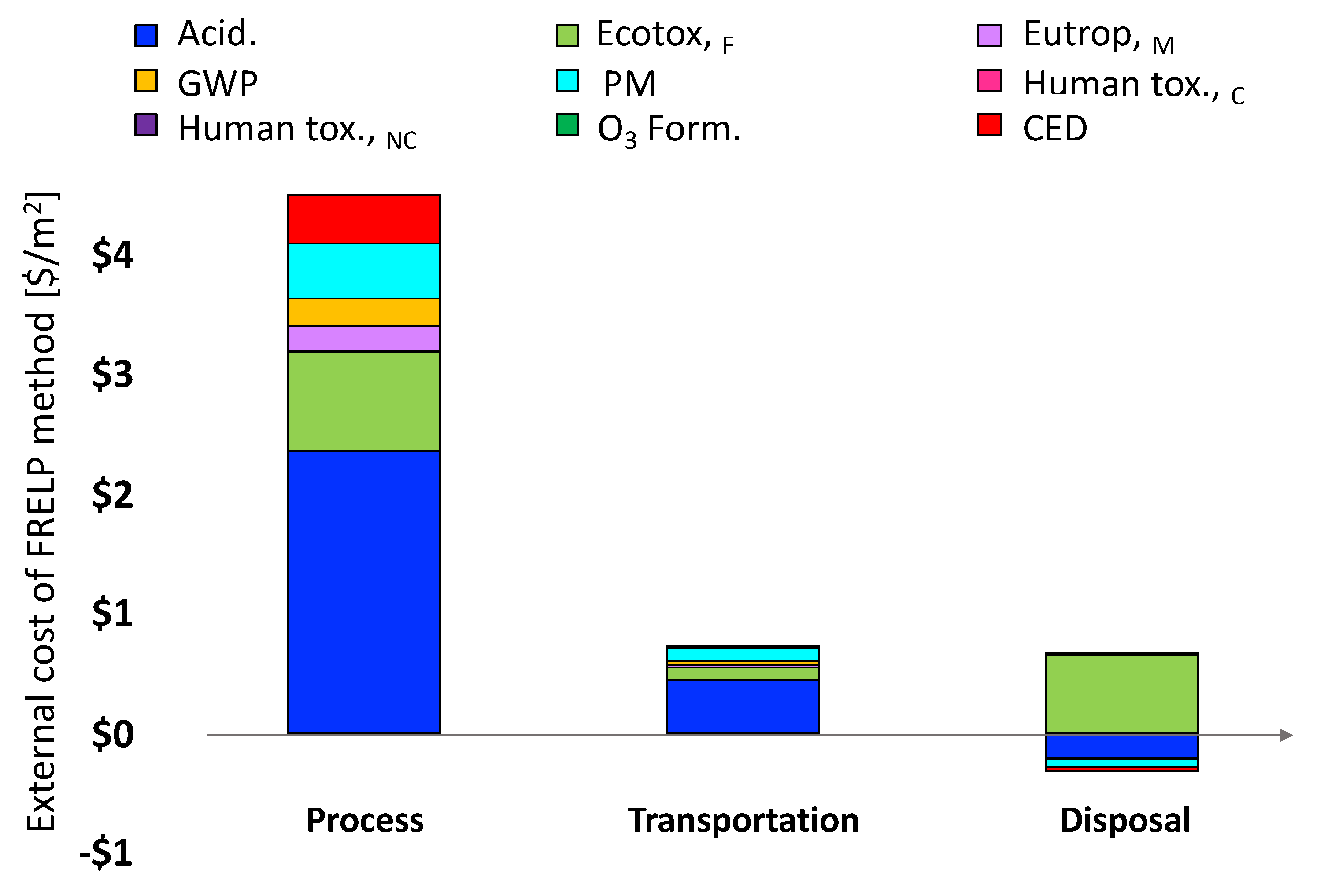
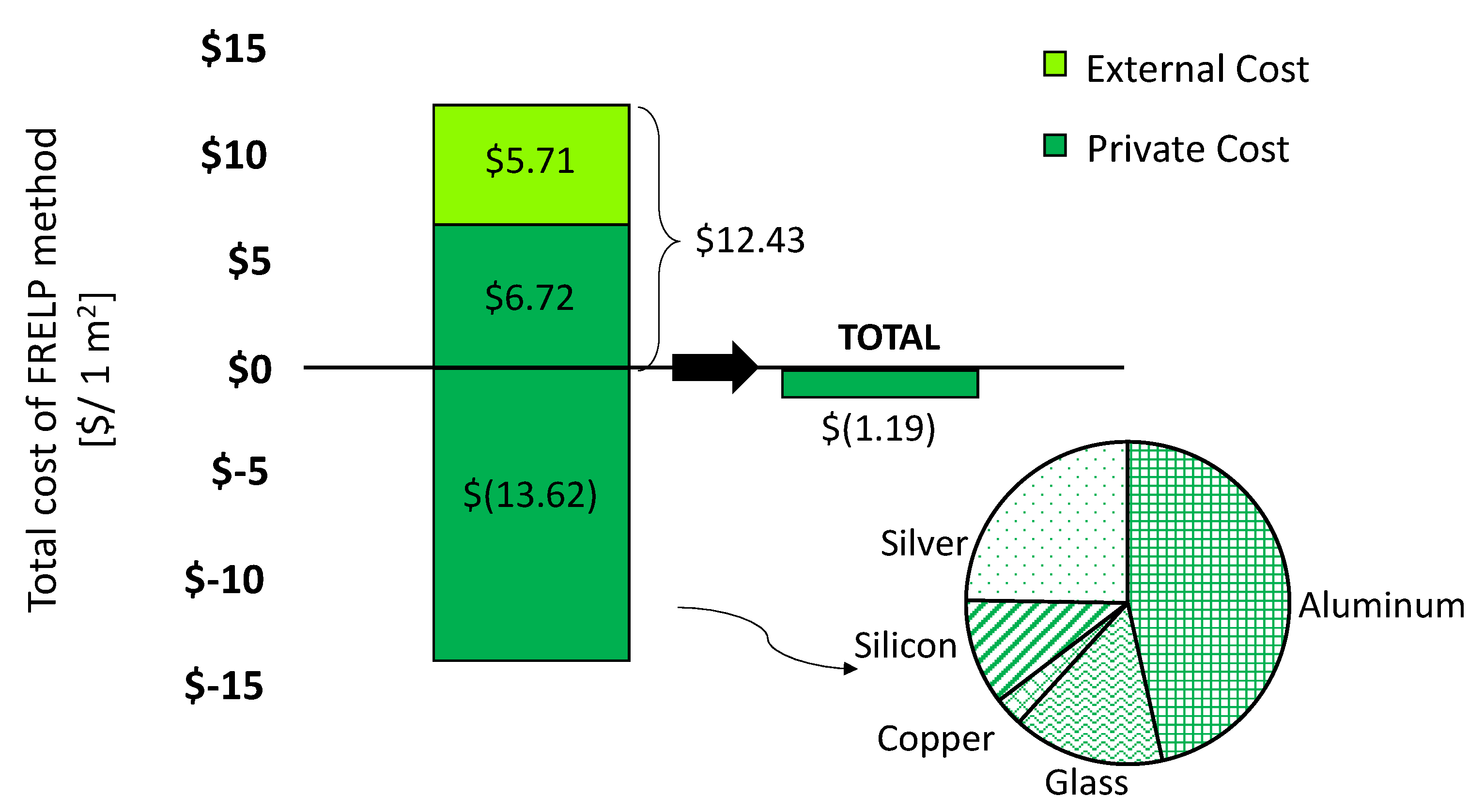
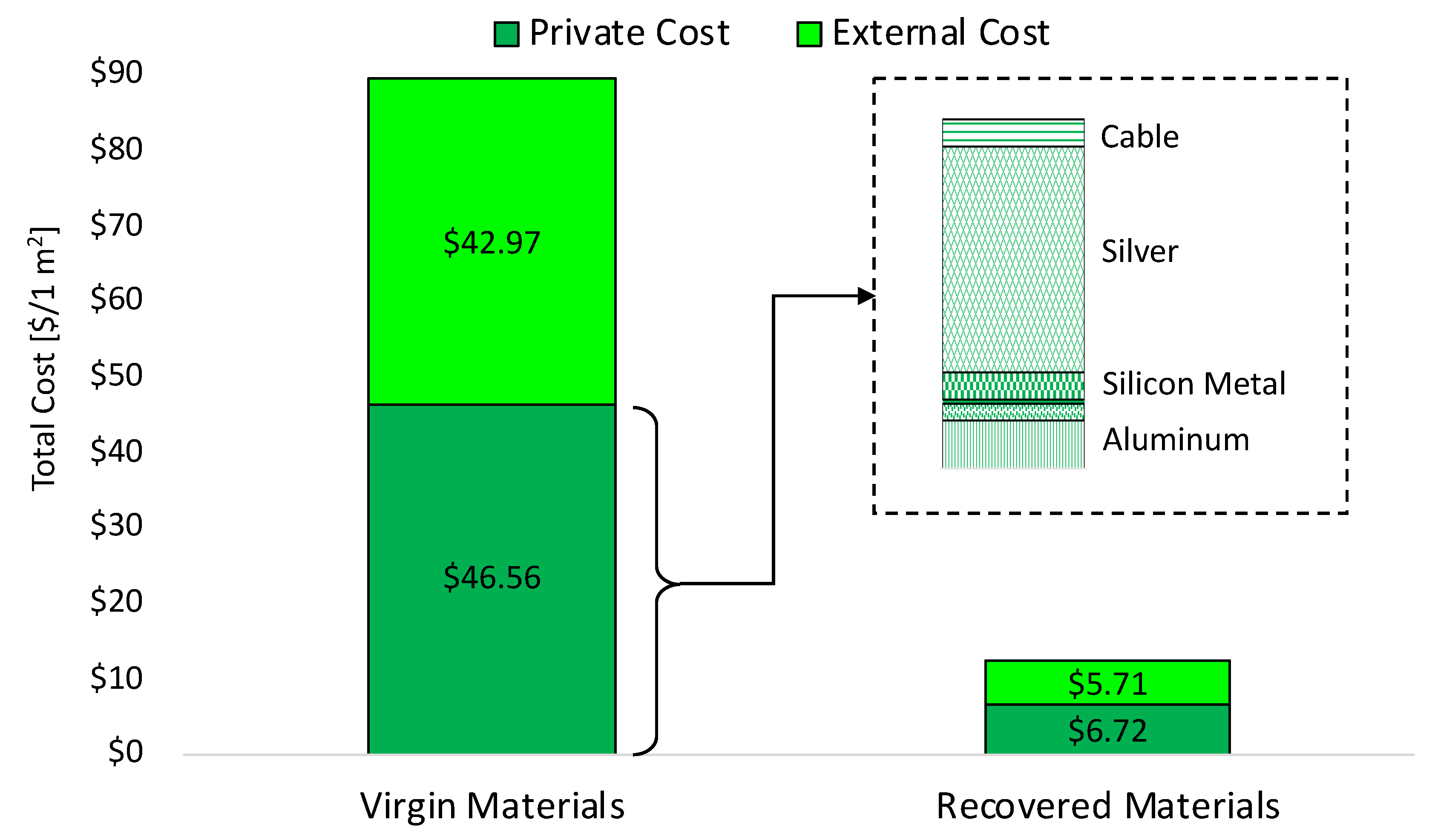
| Impact Category [20] | Abbreviation | Damage Cost ($/kg) |
|---|---|---|
| Cumulative Energy Demand [MJ] | CED | 0.01 [29] |
| Freshwater ecotoxicity [CTUe] | Ecotox.,F | 0.05 [30] |
| Marine eutrophication [kg Neq] | Eutrop.,M | 14.18 [30] |
| Freshwater eutrophication [kg Peq] | Eutrop.,F | 2.02 [30] |
| Acidification [molc H+eq] | Acid. | 64.47 [31] |
| Photochemical ozone formation [NMVOCeq] | O3 Form. | 2.33 [31] |
| Particulate matter [kg PM2.5 eq] | PM | 341.80 [31] |
| Human toxicity, non-cancer effects [CTUh] | Human tox., NC | 0.02 [30] |
| Human toxicity, cancer effects [CTUh] | Human tox., C | 0.02 [30] |
| Global warming potential [kg CO2-eq] | GWP | 0.04 [31] |
© 2020 by the authors. Licensee MDPI, Basel, Switzerland. This article is an open access article distributed under the terms and conditions of the Creative Commons Attribution (CC BY) license (http://creativecommons.org/licenses/by/4.0/).
Share and Cite
Markert, E.; Celik, I.; Apul, D. Private and Externality Costs and Benefits of Recycling Crystalline Silicon (c-Si) Photovoltaic Panels. Energies 2020, 13, 3650. https://doi.org/10.3390/en13143650
Markert E, Celik I, Apul D. Private and Externality Costs and Benefits of Recycling Crystalline Silicon (c-Si) Photovoltaic Panels. Energies. 2020; 13(14):3650. https://doi.org/10.3390/en13143650
Chicago/Turabian StyleMarkert, Elizabeth, Ilke Celik, and Defne Apul. 2020. "Private and Externality Costs and Benefits of Recycling Crystalline Silicon (c-Si) Photovoltaic Panels" Energies 13, no. 14: 3650. https://doi.org/10.3390/en13143650
APA StyleMarkert, E., Celik, I., & Apul, D. (2020). Private and Externality Costs and Benefits of Recycling Crystalline Silicon (c-Si) Photovoltaic Panels. Energies, 13(14), 3650. https://doi.org/10.3390/en13143650






